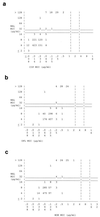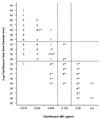Detection of decreased fluoroquinolone susceptibility in Salmonellas and validation of nalidixic acid screening test
- PMID: 10523554
- PMCID: PMC85694
- DOI: 10.1128/JCM.37.11.3572-3577.1999
Detection of decreased fluoroquinolone susceptibility in Salmonellas and validation of nalidixic acid screening test
Abstract
We evaluated 1,010 Salmonella isolates classified as fluoroquinolone susceptible according to the National Committee for Clinical Laboratory Standards guidelines for susceptibility to nalidixic acid and three fluoroquinolones. These isolates were divided into two distinct subpopulations, with the great majority (n = 960) being fully ciprofloxacin susceptible and a minority (n = 50) exhibiting reduced ciprofloxacin susceptibility (MICs ranging between 0.125 and 0.5 microg/ml). The less ciprofloxacin-susceptible isolates were uniformly resistant to nalidixic acid, while only 12 (1.3%) of the fully susceptible isolates were nalidixic acid resistant. A similar association was observed between resistance to nalidixic acid and decreased susceptibility to ofloxacin or norfloxacin. A mutation of the gyrA gene could be demonstrated in all isolates for which the ciprofloxacin MICs were >/= 0.125 microg/ml and in 94% of the nalidixic acid-resistant isolates but in none of the nalidixic acid-susceptible isolates analyzed. Identification of nalidixic acid resistance by the disk diffusion method provided a sensitivity of 100% and a specificity of 87.3% as tools to screen for isolates for which the MICs of ciprofloxacin were >/= 0.125 microg/ml. We regard it as important that microbiology laboratories endeavor to recognize these less susceptible Salmonella strains, in order to reveal their clinical importance and to survey their epidemic spread.
Figures




References
-
- Asperilla M O, Smego R A, Jr, Scott L K. Quinolone antibiotics in the treatment of Salmonella infections. Rev Infect Dis. 1990;12:873–889. - PubMed
-
- Brown J C, Thomson C J, Amyes S G. Mutations of the gyrA gene of clinical isolates of Salmonella typhimurium and three other Salmonella species leading to decreased susceptibilities to 4-quinolone drugs. J Antimicrob Chemother. 1996;37:351–356. - PubMed
-
- Frost J A, Kelleher A, Rowe B. Increasing ciprofloxacin resistance in salmonellas in England and Wales 1991–1994. J Antimicrob Chemother. 1996;37:85–91. - PubMed
Publication types
MeSH terms
Substances
LinkOut - more resources
Full Text Sources

